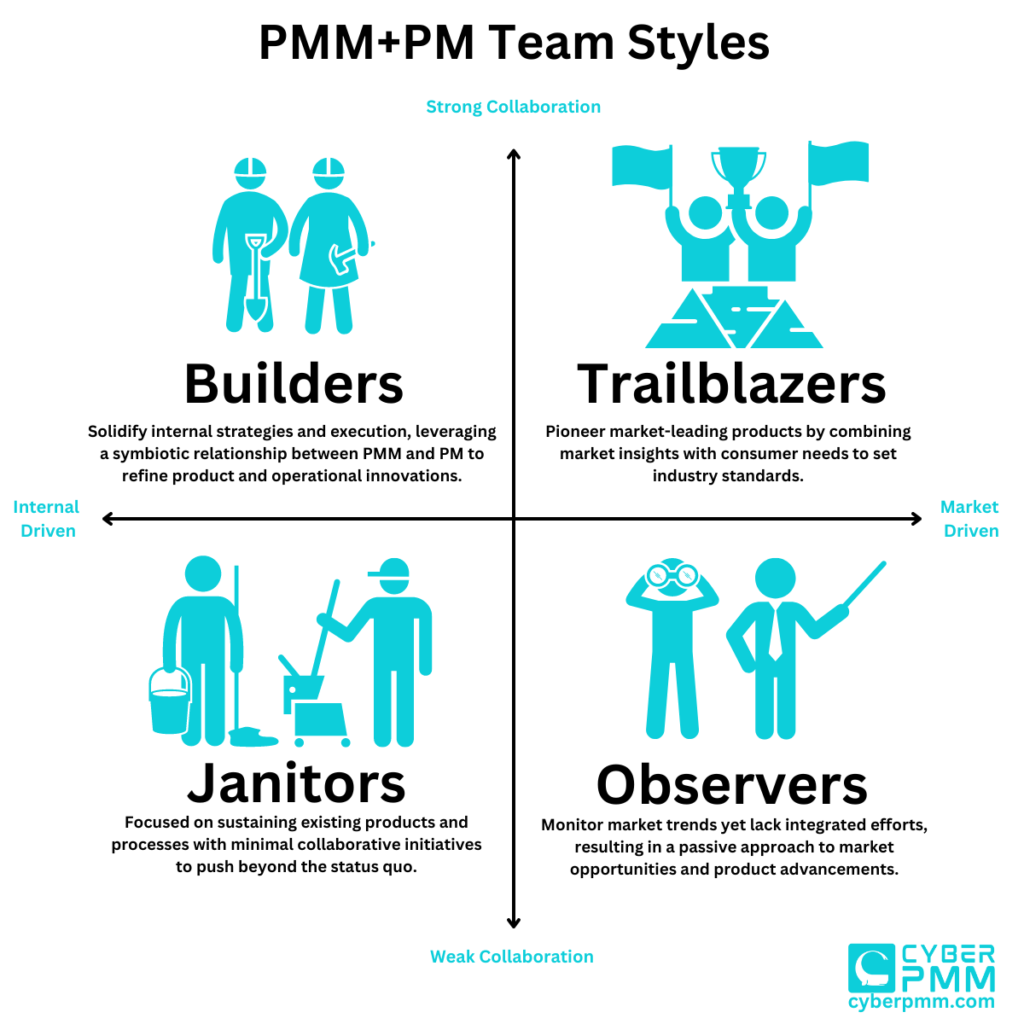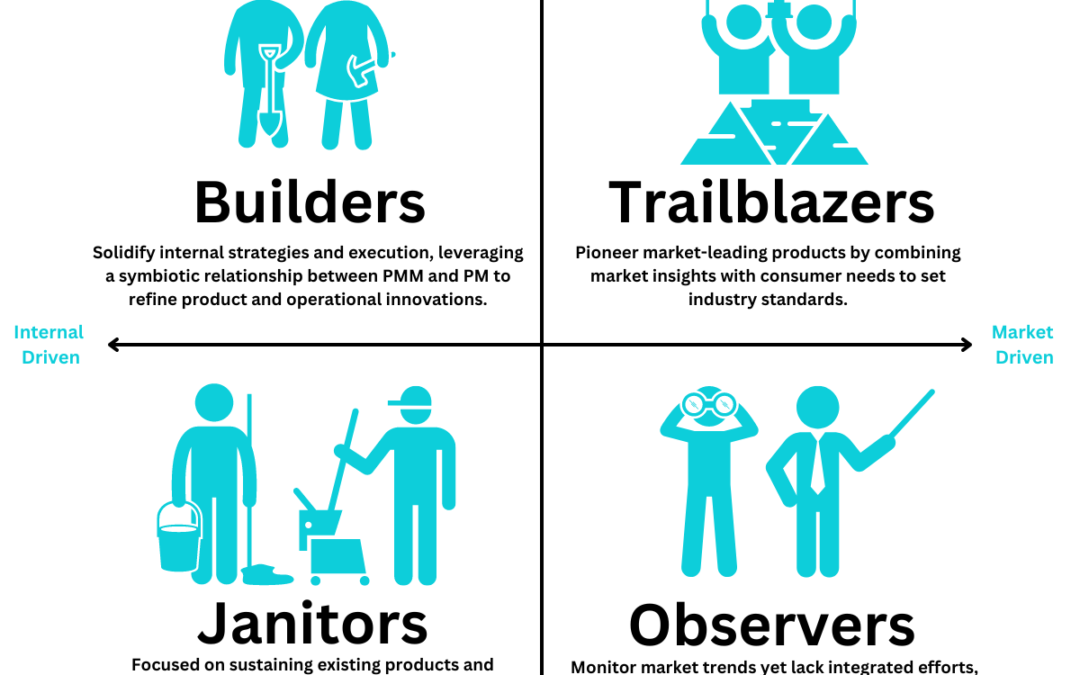“If you want to go fast, go alone. If you want to go far, go with your PM.”
Ancient Cyber PMM Proverb
Introduction
Your most important working relationship as a PMM is with your Product Management (PM) counterpart(s). A solid PMM + PM team is a yin and yang duo that will make or break your product’s success in the market. Getting this relationship right yields more customers, more revenue growth, and more market share. It just makes sense to work together.
This post shares what I’ve learned to help you successfully navigate working with PMs. This is based on working with 30+ PMs across 7 cyber vendors launching dozens of products over the past 11 years. It wasn’t always smooth sailing, though I did work with some great PMs and have seen the impact that a PMM+PM tandem can make.
PMM + PM Team Styles
PMM + PM teams will likely fall somewhere within a matrix between being market driven vs. internal driven, and having strong collaboration vs. weak collaboration. Here are the styles:

- Builders (Internal Driven, Strong Collaboration): Joint teams that solidify internal strategies and execution, leveraging a symbiotic relationship between PMM and PM to refine product and operational innovations.
- Trailblazers (Market Driven, Strong Collaboration): Cohesive PMM and PM teams that pioneer market-leading products, combining market insights with consumer needs to set industry standards.
- Janitors (Internal Driven, Weak Collaboration): PMM and PM teams focused on sustaining existing products and processes with minimal collaborative initiatives to push beyond the status quo.
- Observers (Market Driven, Weak Collaboration): PMM and PM teams that monitor market trends yet lack integrated efforts, resulting in a passive approach to market opportunities and product advancements.
Before you jump to any judgment if you’re not a “trailblazer”, don’t fret. It’s very rare to get there. One reason is that the PM role is exceedingly difficult which is where we’ll turn our attention to next.
5 Key Cyber PM Challenges to Acknowledge
- Cyber PMs are in a tough organizational position
They have a lot on their plate and I would argue are spread too thin. They are essentially a nexus point between go-to-market expectations, customer commits and engineering realities. They move from product development sprint meetings to urgent customer calls to go-to-market enablement sessions on any given day, often put front and center to make key decisions – it’s a lot to manage. - The pressure is on to build and secure the product
The PM role is stressful in cyber because of the added responsibility of building functional software and securing it. Sure, every PM across industries should build secure products. But we all know there are vulnerabilities everywhere. The difference with security products is that if a security vendor’s product isn’t secure, how can we make any claim in the market that we’ll secure others? - Building market-driven roadmaps isn’t easy
One of the most common questions PMs receive is, “where is the roadmap?”. Roadmaps drive product engineering tasks and customer expectations, ideally driven by broader market demand. But if PM’s are disconnected from the market then they end up designing roadmaps that set the company off course. Vendors then go off track when the roadmap to development to release cycle is disconnected from a product-market fit. The pressure is on to get this right. Mistakes here cost the organization several years of innovation debt as they backtrack and recode software to realign with customer needs. - Random demands and org changes are disruptive
Or in other cases, a PM might have a great market-driven roadmap, but a new CPO/VP of PM walks into the org and shuffles everything around. Another disruption might be from a large customer who raises all kinds of chaos and the CEO gets involved directly to drive a certain feature. But just because a single large enterprise needs a feature or function, doesn’t mean it applies across an entire market opportunity. So it puts PMs in a difficult position. - Responsibility without much authority
Just because a date is put on a roadmap by a PM doesn’t mean Engineering will meet it. That’s putting it mildly. PM only has so much sway over large teams of engineers that are being pulled in a hundred directions. And in many organizations, the Engineering function doesn’t report to PM. So when PM gives dates to PMMs and Sales, it’s mostly a guesstimate. Priorities change and the war for engineering resources means that PMs struggle to gain credibility, especially where there’s a track record of missing launch dates.
Learn More about PM
I obviously haven’t even scratched the surface on the PM function. Others have done this much better than I can. A great Audible book (you require an Audible subscription, but it won’t use up a credit) is available called Product Leadership: How Top Product Managers Launch Awesome Products and Build Successful Teams. I highly recommend giving this a listen whether you’re a PMM or PM, or aspiring to be one, or managing the functions. The book has some great examples of what good looks like from a PM perspective based on interviews with 100 PMs. For example, it has a chapter on “Setting a Product Vision” as a critical step for all PMs, and I think PMMs can add value to that process.

5 Tips for Successful PM Alignment as Cyber PMMs
- Know your markets, buyers and competitors
Anytime the conversation starts veering toward the messy internal realities, PMM needs to help bring in the overall market opportunity context. This looks like having market data at the hip such as market research (know the top analyst reports like the back of your hand), security buyer persona profiles (this helps establish conversations that are buyer-based), and competitive intelligence (you need to know your top 3 competitors well). Having this information organized and shareable brings in an outside-in perspective to drive market and customer intelligence. Making decisions based on internal opinions, an executives “gut”, or a single customer’s demands will lead to failure. PMM helps PM avoid this and drives better product positioning and messaging as a result. - Take your seat at the table – be the “outside-in” voice
Many PMMs take a back seat or avoid weighing in with PM. Don’t be shy. You need to speak up and start or barge into the conversation if necessary. This approach will better ensure you have an opportunity to add outside-in value to the decision making process. As an added benefit, it will also ensure you support key releases with adequate time for planning – think less fire drills. By leaning in, you’ll drive better PM collaboration, receive information openly, and get plugged into key discussions. - Respect each other’s time and be product capable
As acknowledged earlier, PMs are faced with a lot of challenges, and so are we. PMMs are often managing multiple PM relationships simultaneously. According to the 2023 State of Product Marketing Report, “the average ratio of PMM to PM in organizations is 1:3; a single PMM takes care of five or more products on average.” So the key is to respect each other’s limited time. For example, don’t schedule too many cadence calls and you should be “product capable” at a 101 and 102 level. This means you can log into the product, give demos and know the key features. If you don’t know the basics, and keep running to PM for simple questions, you’ll be looked at like a nuisance because you are one. Reference the FAQ’s, decks, demo videos first before barraging an already over-extended PM with 101-level questions. And if you aren’t given access to the product, that’s a major red flag – you need to demand it. Don’t take no for an answer. - Remember, you’re on the same side!
You’re both working toward the same goals but it can be easy to lose sight of that in the daily grind. PMMs might think engineering realities are irrelevant, while PMs think a marketing initiative is irrelevant. In the end, you are both trying to get customers to use the same product, grow revenues and win in the market together. You’re on the same side! PMs shouldn’t treat PMM as some kind of adversary when we bring market context to the conversation. Keep asking the outside-in questions however uncomfortable it gets. Meanwhile, be empathetic to engineering realities or resource constraints to balance the two sides of the GTM coin. Teamwork makes the dreamw… too cliche, nevermind. 🙂 - Co-present on key forums
Your strongest content will be done together. I remember an example of this from Splunk’s .conf23. I was a presenter for a session focused on a Splunk product. And right alongside me on stage was the PM. While I presented the market perspective to start the presentation, he presented views inside the product and went into depth with actual live demos. To be successful, we worked closely together to build a coherent message, practiced in person (this was possible because we both lived in Colorado), and ultimately nailed our presentation to 100+ users in Vegas. We also co-presented on a product launch webinar together. The point is to balance content workload across market context (from PMM) with technical “in the product” context (from PM) to make for amazing content. You will both win. (note: stay tuned for a joint post with this PM soon!)

Closing
Cyber PMMs will be fortunate to find a PM who is collaborative and open. When this PM profile is fused with a PMM that is market-driven the possibilities for success are endless. This PMM+PM duo is the yin and yang of a successful product. Cyber PMMs bring the market expertise while PMs bring the product expertise. Working together is just smart. Ignore each other at your own peril. Work together and you will go farther.


